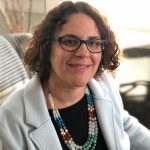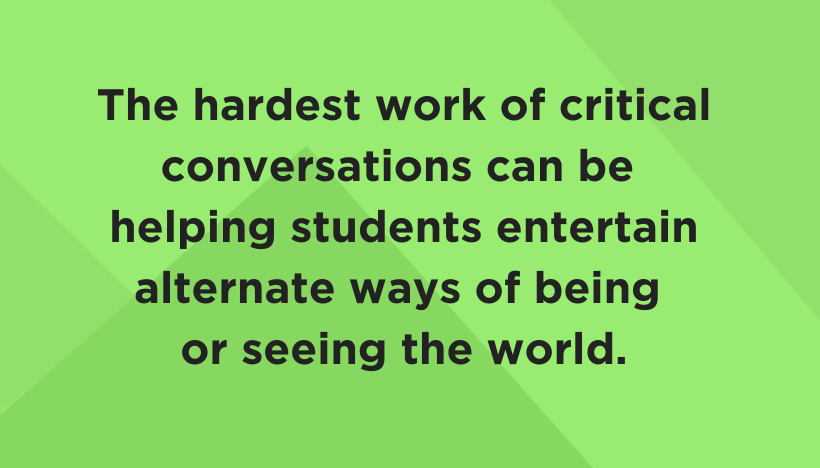This post was written by NCTE members Amy Vetter, Melissa Schieble, and Kahdeidra Monét Martin.
What Are Critical Conversations?
We define critical conversations as discussions about power and privilege that help students critically think about the world and their place in it. The word “critical” in critical conversations stems from the overarching goal of critical theory, which is to confront issues of power, privilege, and hegemony as oppressive forces (Kincheloe et al., 2011).
In the English language arts (ELA) classroom, for example, teachers might engage in conversation about how Jade, the main character in Renee Watson’s Piecing Me Together, feels “shattered into a million pieces” and works with friends and family to piece herself together. As a class, ELA teachers would support students as they explore Jade’s marginalized identities, the complexity of her intersectionality, and how all of those factors complicate her relationships.
What Are Critical Talk Moves?
Teachers oftentimes take on the role of facilitator in these conversations, by asking questions and extending student comments. Such talk moves (i.e. questions, extensions) can be “useful tools that help teachers respond to specific challenges they face in facilitating discussions” (Michaels & O’Connor, 2015, p. 334).
As facilitators of critical conversations, we found it helpful to think of these moves as critical talk moves to emphasize strategies that engage students in adopting a critical stance, disrupting status quo thinking, inviting multiple voices, and leveraging talk for social change. We identify four families of interconnected critical talk moves that help teachers facilitate critical conversations during moment-to-moment interactions: (1) inquiry talk moves; (2) disruptive talk moves; (3) inclusive talk moves; and (4) action talk moves.
Inquiry Talk Moves
Inquiry talk moves include questions that teachers pose about issues of power, privilege, and oppression. Drawing on Freirean critical pedagogies, inquiry talk moves open up opportunities for students to consider underlying messages or ideologies that circulate in a text, and who or what benefits from the text. Inquiry talk moves generally take the shape of questions, but these talk moves can also help teachers and students position themselves as learners about multiple ways of being in the world during critical conversations.
Example questions might include:
- What or who is represented in the text?
- Who or what is missing from the text?
- What do these representations say about youth?
- What knowledge is presented as common sense or normal?
Inquiry talk moves also function to unpack dominant ideologies and clarify concepts. For example, a teacher might ask critical questions that help students unpack wealth disparity in US society and social issues related to present-day income inequality in The Great Gatsby by F. Scott Fitzgerald.
For teachers in well resourced schools, example questions might include “In what ways do we benefit from the neighborhood where our school is located?” or “How do we see power or wealth represented in our community, and how does that help our school?”
Disruptive Talk Moves
Disruptive talk moves involve the moment-to-moment ways teachers and students interrupt and challenge stereotypes, deficit thinking, and racist or sexist remarks during critical conversations. They serve as a pause or rupture in the conversation to unpack ideas. Disruptive talk also challenges the idea that race, for example, is a fixed social category and instead examines its social and historical origins and developments over time. Engaging in disruptive talk moves requires knowledge about power, privilege, and oppression.
Disruptive talk moves often take the form of questions in response to student comments. For example, in a critical conversation about sexual harrassment and abuse, related to Speak by Laurie Halse Anderson, a student might question why so many sexual harassment cases are settled out of court and result in a monetary payment, instead of going before a jury. In the moment, a teacher might ask the class: What are some reasons a woman might want or have to settle a sexual harrassment case? How and why do victims receive damages for the losses sustained as a result of the harassment?
Additionally, disruptive talk moves might speak back to ideas in the text or conversation through personal experience and counternarrative:
- When I was growing up, our family was much different than what is written here . . . .
- I remember when I used to think that . . . and then I realized . . . .
Inclusive Talk Moves
Inclusive talk moves include strategies that facilitate a stance where everyone feels heard. We draw on definitions of inclusion that include the act of creating involvement through an environment in which any individual or group feels welcomed, respected, supported, and encouraged to fully participate (Adams & Zúñiga, 2016).
In the context of critical conversations, inclusive talk moves seek to bring in multiple voices and perspectives on an issue in a way that positions students as active participants in the construction of knowledge.
An important function of inclusive talk moves is to ensure a balance of participation and perspectives. As the teacher, it is important to be mindful of talk patterns in moment-to-moment interactions. Questions to ask yourself as facilitator might include:
- Who is participating?
- Are certain students talking more than other students? What patterns do you notice?
- How can I encourage students who have remained silent to talk?
To bring in multiple voices, inclusive talk involves questions or stems that invite students to draw on their own experiences or to offer an opinion that differs from what has already been said:
- Is there anyone who feels differently about this?
- Let’s hear from some other voices.
- Do you have a similar expression in your language?
- What are some other things that would be important to consider?
- I experienced something similar before. I felt like . . .
Inclusive talk moves also emphasize engaging in discomfort and vulnerability. Teachers can model this by sharing personal stories of benefitting from race or class privilege, or by reporting difficult conversations with family members whose viewpoints on social or political issues differ from ours. Talking aloud about the emotional and physical responses that accompany these moments makes reflexivity and vulnerability an important part of learning.
Action Talk Moves
Action talk moves include strategies that suggest potential actions that individuals might take to address critical issues.
According to Freire (1970), individuals must be actors instead of spectators. Thus, action plays an important role in critical conversations. Action, however, does not mean that individuals must become political activists. Action can include “reading resistantly, communicating new lines of thinking, and pushing others to question how they come to see the world” (Van Sluys, Laman, Legan, & Lewison, 2005, pp. 22–23). Thus, action talk moves are ways that students and teachers can strategize about how to make changes toward equity based on dilemmas they have experienced.
Action talk moves often take the shape of questions or sentence stems. Example questions might include:
- How has the discussion made you think differently about one idea you previously held?
- How can you talk with family and friends about this issue? What might be difficult about this conversation?
- What do you think that we could do as a class and school community about this issue? Where do you see yourself fitting in?
In our experience, the hardest work of critical conversations can be helping students entertain alternate ways of being or seeing the world. For that reason, we think critical conversations should help students with ways to use talk to interrupt harmful discourses they encounter in media or outside of the classroom. Such action talk moves lead to sustained, long-term action in everyday life and collectively hold potential for real social change.
References
Adams, M., & Zúñiga, X. (2016). Getting started: Core concepts for social justice education. In Teaching for diversity and social justice (pp. 113-148). Routledge.
Freire, P. (1970). Pedagogy of the Oppressed. London, UK: Bloomsbury.
Kincheloe, J. L., McLaren, P., & Steinberg, S. R. (2011). Critical pedagogy and qualitative research. The SAGE handbook of qualitative research, 163-177.
Michaels, S., & O’Connor, C. (2015). Conceptualizing talk moves as tools: Professional development approaches for academically productive discussion. Socializing intelligence through talk and dialogue, 347-362.
Van Sluys, K., Laman, T. T., Legan, N., & Lewison, M. (2005). Critical literacy and preservice teachers: Changing definitions of what it might mean to read. Journal of Reading Education, 31(1), 13.
 A former tenth- and twelfth-grade English teacher in Austin, Texas, Amy Vetter is currently a professor in English education at the University of North Carolina–Greensboro, where she teaches undergraduate courses in teaching practices and curriculum of English and literacy in the content area, and graduate courses in youth literacies, teacher research, and qualitative research design. Her areas of research are literacy and identity, critical conversations, and the writing lives of teens. She codirects Gate City Writes, a writing collaborative for teachers and children.
A former tenth- and twelfth-grade English teacher in Austin, Texas, Amy Vetter is currently a professor in English education at the University of North Carolina–Greensboro, where she teaches undergraduate courses in teaching practices and curriculum of English and literacy in the content area, and graduate courses in youth literacies, teacher research, and qualitative research design. Her areas of research are literacy and identity, critical conversations, and the writing lives of teens. She codirects Gate City Writes, a writing collaborative for teachers and children.
 Melissa Schieble is an associate professor of English education at Hunter College of the City University of New York. She is also a consortial faculty member in Urban Education at The Graduate Center, CUNY. A former middle and high school English teacher, her research and teaching focus on critical and sociocultural perspectives on language and literacy, young adult literature, and discourse analysis. Her work has appeared in journals such as English Education, Journal of Teacher Education, Journal of Adolescent and Adult Literacy, and English Teaching: Practice and Critique.
Melissa Schieble is an associate professor of English education at Hunter College of the City University of New York. She is also a consortial faculty member in Urban Education at The Graduate Center, CUNY. A former middle and high school English teacher, her research and teaching focus on critical and sociocultural perspectives on language and literacy, young adult literature, and discourse analysis. Her work has appeared in journals such as English Education, Journal of Teacher Education, Journal of Adolescent and Adult Literacy, and English Teaching: Practice and Critique.
 Kahdeidra Monét Martin began her education career as a tutor, youth facilitator, and after-school coordinator at community-based organizations throughout NYC. Kahdeidra holds a BA in African and African American Studies from Stanford University and an MSEd in Teaching Urban Adolescents with Disabilities from Long Island University, Brooklyn Campus. She is currently a Postdoctoral Fellow at Stanford Graduate School of Education and is interested in culturally relevant and universally designed English teacher education, critical pedagogy, game-based learning, and multi-modal approaches to cultivate racial literacy among teachers and students.
Kahdeidra Monét Martin began her education career as a tutor, youth facilitator, and after-school coordinator at community-based organizations throughout NYC. Kahdeidra holds a BA in African and African American Studies from Stanford University and an MSEd in Teaching Urban Adolescents with Disabilities from Long Island University, Brooklyn Campus. She is currently a Postdoctoral Fellow at Stanford Graduate School of Education and is interested in culturally relevant and universally designed English teacher education, critical pedagogy, game-based learning, and multi-modal approaches to cultivate racial literacy among teachers and students.
It is the policy of NCTE in all publications, including the Literacy & NCTE blog, to provide a forum for the open discussion of ideas concerning the content and the teaching of English and the language arts. Publicity accorded to any particular point of view does not imply endorsement by the Executive Committee, the Board of Directors, the staff, or the membership at large, except in announcements of policy, where such endorsement is clearly specified.

